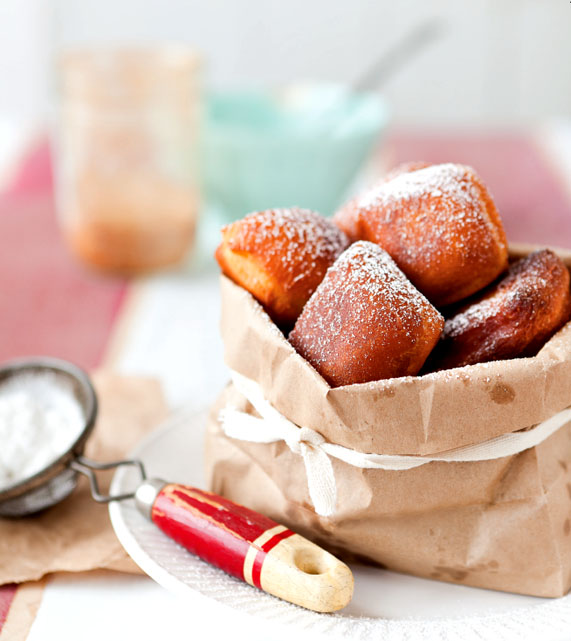
Makes 36 small doughnuts
Doughnuts need not be a labor of love, and these simple drop doughnuts prove just that with their simplicity. Apple cider is boiled and reduced down to concentrate the flavor, while yogurt is added to a yeasted dough for a bit of tang. The sour-sweet combination makes for a super-tasty doughnut that can be shaken with powdered sugar or a cinnamon-sugar. For a light and fluffy doughnut, make sure you don’t overmix the batter, which will stimulate the gluten in the flour and create a tougher texture.
5 cups all-purpose flour
3 tablespoons baking powder
1 teaspoon ground cinnamon
1 teaspoon ground nutmeg
1 tablespoon salt
½ cup (1 stick) unsalted butter, at room temperature
1 cup granulated sugar
3 large eggs
½ cup plain yogurt
1 tablespoon vanilla extract
2 cups apple cider, boiled until reduced by half (1 cup total)
Vegetable oil, for frying
1 cup powdered sugar or 1 cup granulated sugar plus 1 teaspoon ground cinnamon, for serving
In a medium bowl, add the flour, baking powder, cinnamon, nutmeg, and salt. Stir to combine thoroughly and set aside.
In the bowl of an electric mixer, cream the butter and sugar on medium-high speed until light and fluffy, about 5 minutes. Scrape down the sides of the bowl, if necessary. Add the eggs one at a time, mixing until well incorporated, making sure to scrape the sides of the bowl between each addition.
Once the eggs are blended fully, add half of the dry ingredients and mix until well combined, about 1 minute. Pour in the yogurt and vanilla and mix briefly, until just combined. Add the remainder of the dry ingredients and mix until incorporated. These last 2 steps should take 1 minute total.
Add the reduced apple cider to the bowl and mix until just combined—there may be a few lumps. Cover the surface of the dough with a layer of plastic wrap and refrigerate until cold, 2 to 3 hours.
Turn the dough out onto a floured countertop and knead it briefly to even it out into a soft mound. The dough should be soft with a smooth surface; it won’t need much flour incorporated. Pat or roll the dough into a wide rectangular shape about 1½ inches thick. Using a knife, cut the dough into small 2-inch squares.
When you’re ready to fry the doughnuts, add about ½ inch of oil to a large sauté pan, and set the pan over medium heat. The oil is ready when it hits 375 degrees F, or a small piece of dough dropped in bubbles quickly and floats. Using a small spatula, drop the doughnuts into the hot oil and fry, being careful not to overcrowd the pan. Cook on one side until golden brown, about 2 minutes, and turn over. Cook the other side until golden brown, another 2 minutes or so. When they’re brown, drain the doughnuts on several layers of paper towel or on a paper bag and cool slightly. Once they’re cool enough to handle, but still warm, either shake powdered sugar over them or toss in cinnamon-sugar.
Any extra dough can be shaped, cut, and frozen for frying at a later date.

Choosing the right apples for baking the perfect apple pie is a debatable and subjective topic, particularly as more varieties of apple become available.
Aim to choose apples that are both tart and slightly sweet. Apples should maintain their apple-y flavor through baking. A pie that balances the acidity of a tart apple (like Granny Smith) with the sweetness from another variety (Honeycrisp) is a winner. Apples range in flavor, however, even within varieties. Sun, temperature, and harvest time all affect taste, so while one year Orin apples may be perfectly delicious, the next year’s harvest may fall flat. It is important that you taste apples before you buy. If you’re at a farmers’ market, most farms will oblige and cut a sliver for tasting. Ditto in some grocery stores, and it couldn’t hurt to ask.
Texture, too, plays a big part in choosing the appropriate pie apple—flesh that holds its shape and allows for a bit of bite in a done pie is preferable. My goal is to bake up a pie with both texture and give, leaving some apples whole while other thin slices break down to near-sauce. Personally, I like a mixture in my pie and refuse to commit to one variety.
Cider apples make for good pie apples as well. Any of the Russets will maintain both their flavor and their shape in a pie. Because cider apples can be more acidic, you may need to adjust the sugar level in the filling. Taste and decide on your own.
Nationally, Braeburn, Golden Delicious, and Granny Smith are widely available, and all will make an excellent start to any pie. Add a Jonathan, Northern Spy, Macoun, Gravenstein, or Winesap and you’ll be off to a great start.